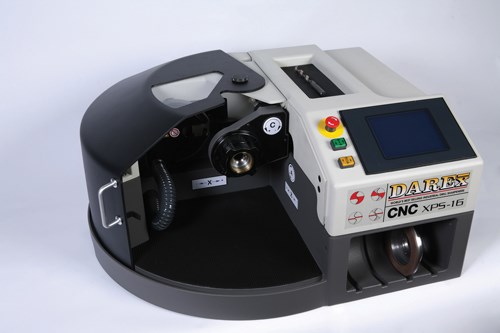Less Downtime with In-House Drill Sharpening
An important goal for any shop should be improving productivity through faster turnaround and reduced machine downtime.
An important goal for any shop should be improving productivity through faster turnaround and reduced machine downtime. Being able to process work more quickly, accurately and cost effectively provides a natural advantage over the competition.
One step toward higher productivity can be in addressing the long wait times often associated with outsourced drill sharpening. With equipment that can provide high accuracy and consistent results, bringing this operation in-house can save time and money.
Sharpen In-House
Darex LLC produces industrial drill sharpeners that are suitable for in-house applications, along with a range of other commercial and consumer sharpening products. Its CNC-XPS-16 has recently been upgraded with a low-power-usage LED backlit display and electronics with refined grind motion control to meet demanding sharpening requirements.
The unit sharpens drills accurately in less than a minute. The super-abrasive, electroplated, sharpening wheels can sharpen more than 8,000 drills and are replaceable. The enclosed design and dust extraction system ensure grinding dust and grit are contained. The machine sharpens two-fluted split-point drills, high speed steel, cobalt, carbide and coated drills from 2 inches to 10 inches long. It can automatically hone carbide drill cutting edges as part of the sharpening process and can turn regular drills into self-centering, fast-cutting, high performance drills.
The machine can sharpen both standard conic and four-facet points, as well as produce standard and high performance radius split points. It can sharpen drills 1/8 inch to
5/8 inch in diameter (3 mm to 16 mm) and can create angles from 90 degrees to 150 degrees.
Product Details
The XPS 16 is designed for ease of use. The operator simply selects the drill point angle and pushes “cycle start” to automatically size, align, sharpen, split, and if desired, hone the drill. The sharpener detects the end of the drill and determines the drill diameter. In one continuous step prior to sharpening, using fiber optics, the web thickness is measured, and the cutting edge of the drill is located for auto alignment.
Once the drill is secured in the chuck, the programming is done via the LCD touchscreen. The cycle start/cycle stop and the emergency stop buttons are located next to the LCD screen. From the main setup screen, the operator has the ability to adjust a number of variables, including honing, point angle, relief angle and point split options. As many as 100 custom profiles can be saved in the system through the file management icon.
The latest model includes new electronics with refined grind motion control. With the older model, the motion to remove material was done in paused, step increments. Now, with the refined motion control, the conic acceleration and deceleration improves surface finish and cycle times.
Changes have been made that will help improve wheel life. Previously, the drill bit diameter determined the grind position on the wheel. In cases when sharpening only common size drill bits, only a small portion of the wheel was consumed. Now, the drill’s sharpening position on the wheel is random, utilizing the entire face of the grinding wheel.
The unit is shipped with two wheels. The CBN wheel is specific for high speed steel and cobalt, and the diamond wheel is specific for carbide. Additional wheel options are available with varying grit sizes to meet certain surface finish requirements.
No Time to Wait
When a shop is busy getting parts out the door, it is hard to justify a long wait for drills to return from independent sharpening services. The process can sometimes take as long as 6 weeks. Sharpening drills in-house with a system such as the XPS-16 is not only more expedient, but also significantly reduces perishable tooling costs.
By providing consistent sharpening from one drill to the next, the machine contributes to a shop’s efforts toward efficient operations with repeatable results.
Related Content
Shop Sets its Sights on Precise Tool Alignment
A Wisconsin shop has found that visual tool alignment technology has improved tool life and surface finishes for its Swiss-type lathes while increasing throughput as well.
Read MoreData Matrix Codes Offer Cutting Tool Traceability
A company’s quest to discover errors in a manufacturing process has led to printing data matrix codes on its cutting tools that provide a wealth of information for both the user and this cutting tool manufacturer.
Read MoreNew Cutting Tool Technology Discovered at Paul Horn Open House
During a tour of the company’s campus in Tubingen, Germany, I and more than 3,000+ others were introduced to a number of new advances the company has made in cutting tool technology particularly as it relates to the medical industry.
Read MoreMicromachining Fundamentals
A number of elements must come together to establish an effective process for machining at a micro level. Here we consider four.
Read MoreRead Next
Drill Sharpener Helps Shop Hone Competitive Edge
Bringing drill sharpening operations in-house saved both time and money at this Chicago-based manufacturer. However, the sharpener itself, Darex’s XPS-16, provided additional benefits—with high accuracy and consistent results, the machine helped the company maintain precision and quality.
Read More5 Aspects of PMTS I Appreciate
The three-day edition of the 2025 Precision Machining Technology Show kicks off at the start of April. I’ll be there, and here are some reasons why.
Read MoreA Tooling Workshop Worth a Visit
Marubeni Citizen-Cincom’s tooling and accessory workshop offers a chance to learn more about ancillary devices that can boost machining efficiency and capability.
Read More














.png;maxWidth=300;quality=90)









